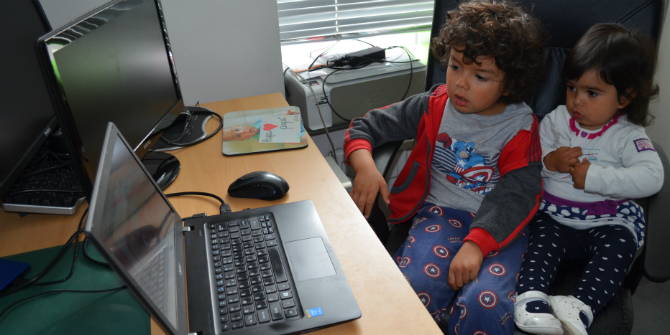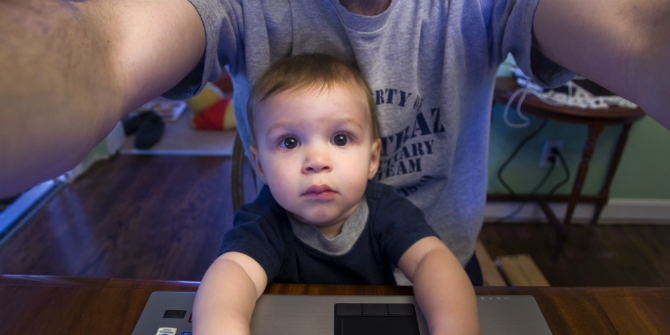 Heated debates focus on new and emerging technologies in the lives of children, young people, families and schools. New research, out this week, brings together the perspectives of tech industry insiders and those of young people, parents, and educators across Europe, to explore the future of tech and provide practical recommendations. Alicia Blum-Ross led the research project while she was the Research Officer on the Parenting for a Digital Future project and a Visiting Fellow at the LSE.
Heated debates focus on new and emerging technologies in the lives of children, young people, families and schools. New research, out this week, brings together the perspectives of tech industry insiders and those of young people, parents, and educators across Europe, to explore the future of tech and provide practical recommendations. Alicia Blum-Ross led the research project while she was the Research Officer on the Parenting for a Digital Future project and a Visiting Fellow at the LSE.
From checking homework assignments while playing Fortnite with schoolmates, to ordering the family shopping via smart home devices, digital technologies are firmly embedded in the present and future lives of families.
Our new report draws insights from industry experts responsible for shaping technology, and from focus groups with young people, parents, and teachers living out these debates. On the one hand, new technologies are welcomed, and in the words of an industry expert, soon “become wallpaper”. On the other, as one teen mused, conveniences have trade-offs and, “if you become more and more lazy then you lose the beautiful things that fill your day.” This report explores the present tensions within tech use at home and at school – and projects into the next two-to-five years to make predictions about emerging tech, threats and opportunities.
The report was commissioned by the ICT Coalition for Children Online, a membership organisation for ICT companies that “aims to help younger internet users across Europe to make the most of the online world and deal with any potential challenges and risks.” Here we set out some of the key points and the implications and recommendations for technology developers.
- Families are spending a substantial portion of their leisure time using digital technologies, but parents of younger children struggle with identifying positive or educational content and services and with avoiding inappropriate or unsafe material.
Parents and young people appreciate that digital technology is constantly available and a uniquely engaging source of learning and inspiration. Yet parents and children both have a difficult time locating the content and tools they value and that have the most benefit within a highly crowded market.
We recommend that companies take proactive steps to increase the discoverability of good kids’ content, and the avoidance of inappropriate material. We further suggest that, given children and parents all have different values and needs, tools and content for families should reflect the range of user diversity.
- Older children and parents struggle with the amount of time they each spend online and want tools and support to help ensure this time is well spent.
Families experience many disagreements about ‘screen time’. However, when parents impose blanket restrictions, frustration and conflict often result. We recommend that companies facilitate dialogue between parents and children about the benefits each can gain from their time online as well as the issues that they struggle with. While ‘tech addiction’ has become a popular concern, many teens described a more self-reflective understanding of their own tech use. A teenage boy said: “You know if you use like a phone or something, if you use it a lot you know you might get addicted, and you might start to neglect the people around you.”
We recommend that new services and business models disincentivise ‘always on’ use and encourage joint-use (including amongst parents, siblings, and peers).
- Parents and young people are both excited about and sceptical of the Internet of Things.
While valuing potential conveniences, parents and young people are concerned about the impact that new technologies like ‘smart homes’ and the Internet of Things will have on physical health, privacy and relationships. Excitement is counterbalanced by this and the reality that much emerging technology remains unaffordable for many. Our focus groups encapsulated this tension – for example several people described smart home devices as being a kind of “slave”, while, at the same time, as “practical, but also kind of awesome”. These suggest that new ‘smart’ devices should be developed with the principles of safety and privacy by design embedded, and include children and parents in the design and evaluation.
- Parents and young people value digital conveniences, and the peace of mind technology can bring, but the ability to be constantly in touch also creates new pressures and anxieties.
Digital technologies give children greater freedom but also create pressure for parents and children. Yet to disconnect means missing out on valued participation, and once digital platforms are introduced, parents may be seen as negligent if they do not use them. For example, parents discussed how they had given their ‘tween’ girls phones when away from home, bringing each peace of mind. But they also observed how it led to groups of girls at parties, constantly responding to messages from their own parents.
We recommend that new tools and services need to be mindful of both these opportunities and these potential pressures. Children’s rights – to freedom of movement and participation, to expression and to knowledge-seeking – need to be counterbalanced by their need for protection from potential risk to their physical and mental health.
- Young people find ways of managing when they have difficult experiences online, but rarely do they turn to parents, teachers, or industry (e.g. reporting inappropriate content or contact) as resources to deal with these.
Only a minority of young people (or indeed parents or teachers) knew how to report inappropriate content they had seen online, or in some cases they assumed that the companies would (in the words of a teenager) “do nothing. You can report as much as you want but there are too many requests.” We recommend that platforms continue to develop simplified reporting tools. We also suggest that actions taken by companies must be more transparent to users, reporting tools must be promoted and that those who use them must feel their complaint has been appropriately dealt with.
- Industry has been proactive in providing services, resources and programmes to help support children’s safety and digital literacy online, from parental control tools to educational outreach. However, the impact of these initiatives and the uptake of tools are unclear.
There is little available research on whether or not digital wellbeing tools and digital literacy interventions are effective. We suggest that industry pursue research practice partnerships in order to understand the uptake and the short- and long-term impact of digital wellbeing and screen time tools. We recommend that industry- NGO- and government-led digital literacy initiatives should be independently evaluated not only against short term indicators like how many young people they reach, but also longitudinal impacts.
- Only a minority of children are engaging in creative digital opportunities either at home or at school. Teachers are interested in using emerging technologies but experience significant challenges like the lack of connectivity, equipment and training.
Some teachers use educational apps, platforms, and hardware in creative ways within their schools, but often they are the minority. Significant resources need to be devoted to ensuring that the use of educational technologies does not simply replicate existing inequalities. At present, many teachers lack basic skills and access – for example teachers described a host of technical, bureaucratic, personnel and leadership challenges from a lack of training and limited WiFi, to tablets locked up in hard-to-access cabinets.
Even with easily available devices (like children’s own phones), teachers struggled with creating a positive vision for integrating digital skills into other areas of the curriculum. We recommend that teachers be given sufficient training to understand how to use digital devices in positive ways to support classroom activities and digital creativity.
Technology will continue to become embedded in the daily lives of families and in the physical infrastructure of their homes. As our report shows, there’s a lot to be done, to ensure these developments support the wellbeing of our children.
Notes
The report was co-authored by Verónica Donoso, a digital literacy consultant and researcher in Belgium, Thuy Dinh and Brian O’Neill from the Dublin Institute of Technology, Giovanna Mascheroni from Università Cattolica del Sacro Cuore, Claudia Riesmeyer from Ludwig-Maximilians University and Mariya Stoilova from the LSE. The full report is available here.





